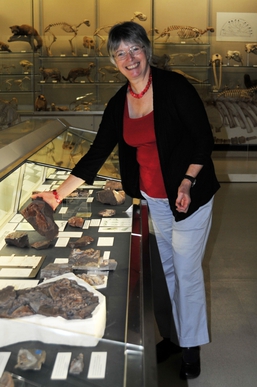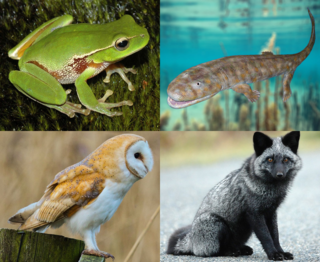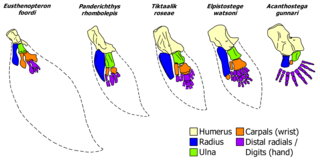
A tetrapod is any four-limbed vertebrate animal of the superclass Tetrapoda. Tetrapods include all extant and extinct amphibians and amniotes, with the latter in turn evolving into two major clades, the sauropsids and synapsids. Some tetrapods such as snakes, legless lizards, and caecilians had evolved to become limbless via mutations of the Hox gene, although some do still have a pair of vestigial spurs that are remnants of the hindlimbs.

Jennifer Alice Clack, was an English palaeontologist and evolutionary biologist. She specialised in the early evolution of tetrapods, specifically studying the "fish to tetrapod" transition: the origin, evolutionary development and radiation of early tetrapods and their relatives among the lobe-finned fishes. She is best known for her book Gaining Ground: the Origin and Early Evolution of Tetrapods, published in 2002 and written with the layperson in mind.
Romer's gap is an example of an apparent gap in the tetrapod fossil record used in the study of evolutionary biology. Such gaps represent periods from which excavators have not yet found relevant fossils. Romer's gap is named after paleontologist Alfred Romer, who first recognised it. Recent discoveries in Scotland are beginning to close this gap in palaeontological knowledge.

Casineria is an extinct genus of tetrapod which lived about 340-334 million years ago in the Mississippian epoch of the Carboniferous period. Its generic name, Casineria, is a latinization of Cheese Bay. The site near Edinburgh, Scotland where the holotype fossil was found. When originally described in 1999, it was identified as a transitional fossil noted for its mix of basal (amphibian-like) and advanced (reptile-like) characteristics, putting it at or very near the origin of the amniotes, the group containing all mammals, birds, modern reptiles, and other descendants of their reptile-like common ancestor. However, the sole known fossil is lacking key elements such as a skull, making exact analysis difficult. As a result, the classification of Casineria has been more controversial in analyses conducted since 1999. Other proposed affinities include a placement among the lepospondyls, seymouriamorphs, "gephyrostegids", or as a synonym of Caerorhachis, another controversial tetrapod which may have been an early temnospondyl.

Embolomeri is an order of tetrapods or stem-tetrapods, possibly members of Reptiliomorpha. Embolomeres first evolved in the Early Carboniferous (Mississippian) Period and were the largest and most successful predatory tetrapods of the Late Carboniferous (Pennsylvanian) Period. They were specialized semiaquatic predators with long bodies for eel-like undulatory swimming. Embolomeres are characterized by their vertebral centra, which are formed by two cylindrical segments, the pleurocentrum at the rear and intercentrum at the front. These segments are equal in size. Most other tetrapods have pleurocentra and intercentra which are drastically different in size and shape.

Pederpes is an extinct genus of early Carboniferous tetrapod, dating from 348 to 347.6 Ma in the Tournaisian age. Pederpes contains one species, P. finneyae, 1 m long.

Megalocephalus is an extinct genus of baphetid amphibian from the late Carboniferous of the British Isles and the United States (Ohio). It contains two species, M. pachycephalus and M. lineolatus.

Stegocephali is a group containing all four-limbed vertebrates. It is equivalent to a broad definition of Tetrapoda: under this broad definition, the term "tetrapod" applies to any animal descended from the first vertebrate with limbs and toes, rather than fins. This includes both the modern lineage of limbed vertebrates as well as a portion of the stem group, limbed vertebrates that evolved prior to the origin of the crown group. Members of the tetrapod stem group include the earliest limbed tetrapodomorphs such as Ichthyostega and Acanthostega, which evolved in the Devonian Period long before any modern form of tetrapod.

Polydactyly in stem-tetrapods should here be understood as having more than five digits to the finger or foot, a condition that was the natural state of affairs in the earliest stegocephalians during the evolution of terrestriality. The polydactyly in these largely aquatic animals is not to be confused with polydactyly in the medical sense, i.e. it was not an anomaly in the sense it was not a congenital condition of having more than the typical number of digits for a given taxon. Rather, it appears to be a result of the early evolution from a limb with a fin rather than digits.

Ossinodus is an extinct genus of stem tetrapod. Fossils have been found from the Ducabrook Formation in Queensland, Australia dating back to the middle Visean stage of the Early Carboniferous (Mississippian). It was originally placed within the family Whatcheeriidae, but the absence of an intertemporal bone as suggested by a recent reconstruction of the skull based on fragmentary material may prove it to be stemward of all whatcheeriids.

Ichthyostegalia is an order of extinct amphibians, representing the earliest landliving vertebrates. The group is thus an evolutionary grade rather than a clade. While the group are recognized as having feet rather than fins, most, if not all, had internal gills in adulthood and lived primarily as shallow water fish and spent minimal time on land.

Occidens is an extinct genus of stem tetrapod that lived during the earliest part of the Carboniferous in what is now Northern Ireland. It is known from a single type species, Occidens portlocki, named in 2004 on the basis of a left lower jaw described by British geologist Joseph Ellison Portlock in 1843.

The Ballagan Formation is a geologic formation in Scotland and England. It preserves fossils dating back to the early part of the Carboniferous period. Its name comes from the "Ballagan Beds" of Ballagan Glen, near Strathblane, which has a good example of this geological formation.
The arthropod gap is an apparent gap in the arthropod fossil record used in the study of evolutionary biology. It still occurs in the early Carboniferous, coinciding and extending past the Romer's gap for tetrapods, who were newly arriving on land.
Tantallognathus is an extinct genus of four-limbed vertebrate ("tetrapod") from the Mississippian of Scotland. It is based on a small jaw fragment which shows similarities to Crassigyrinus, baphetids, and crown group tetrapods. This fossil was found near Tantallon Castle, and the species name honors famed Scottish fossil collector Stan Wood. Tantallognathus is one of the most advanced tetrapods found in the Ballagan Formation, a geological unit known for a diverse fauna of stegocephalians. Like other Ballagan Formation vertebrates, it helps to clarify a pulse of tetrapod evolution during Romer's gap, a time interval when fossils of tetrapods and their relatives are otherwise very rare.
Diploradus is an extinct genus of four-limbed stem-tetrapod from the Mississippian (mid-Tournaisian) of Scotland. It contains a single species, Diploradus austiumensis, based on an incomplete skull and jaw fragments from the Ballagan Formation at Burnmouth. The most complete part of the specimen, the lower jaw, was about 3.0 cm in length and possessed several rows of small, numerous teeth. It likely represents a juvenile animal. Diploradus was described in a 2016 study which was devised to fill in the tetrapod and stem-tetrapod faunas of Romer's gap, an interval of the early Carboniferous with few vertebrate fossils. It was one of five new genera named in this study, along with Aytonerpeton, Koilops, Ossirarus, and Perittodus.
Koilops is an extinct genus of four-limbed stem-tetrapod from the Mississippian (mid-Tournaisian) of Scotland. It contains a single species, Koilops herma, based on a mold of an 8.0 cm -long skull from the Ballagan Formation. A phylogenetic analysis in its original description places Koilops as a close relative of Tulerpeton and colosteids. Koilops was described in a 2016 study which was devised to fill in the tetrapod and stem-tetrapod faunas of Romer's gap, an interval of the early Carboniferous with few vertebrate fossils. It was one of five new genera named in this study, along with Aytonerpeton, Diploradus, Ossirarus, and Perittodus.
Ossirarus is an extinct genus of four-limbed stem-tetrapod from the Mississippian (mid-Tournaisian) of Scotland. It contains a single species, Ossirarus kierani, based on disarticulated skull and postcranial bones from the Ballagan Formation at Burnmouth. It would have had a large, pointed tabular horn and several minor traits shared with Devonian stem-tetrapods. Ossirarus was described in a 2016 study which was devised to fill in the tetrapod and stem-tetrapod faunas of Romer's gap, an interval of the early Carboniferous with few vertebrate fossils. It was one of five new genera named in this study, along with Aytonerpeton, Diploradus, Koilops, and Perittodus.
Perittodus is an extinct genus of four-limbed stem-tetrapod from the Mississippian (mid-Tournaisian) of Scotland. It contains a single species, Perittodus apsconditus, based on disarticulated skull and postcranial bones from the Ballagan Formation. The lower jaw of the holotype specimen was about 6.8 cm in length and had a pattern of dentition similar to the Devonian taxon Ymeria. Perittodus was described in a 2016 study which was devised to fill in the tetrapod and stem-tetrapod faunas of Romer's gap, an interval of the early Carboniferous with few vertebrate fossils. It was one of five new genera named in this study, along with Aytonerpeton, Diploradus, Koilops, and Ossirarus.
Mesanerpeton is an extinct genus of four-limbed stem-tetrapod from the Mississippian (Tournaisian) of Scotland. It contains a single species, Mesanerpeton woodi, who based on a disarticulated specimen including a clavicle, vertebrae, and forelimb bones from the Ballagan Formation. The vertebrae are poorly-ossified and similar to Crassigyrinus, but the forelimb was robust. The shape and level of torsion present in the humerus are intermediate between Devonian stem-tetrapods and later Carboniferous tetrapods. This transitional condition, and the associated rerouting of the brachial artery and median nerve, may indicate that Mesanerpeton had a higher stride length and more efficient locomotion on land compared to its predecessors.

















